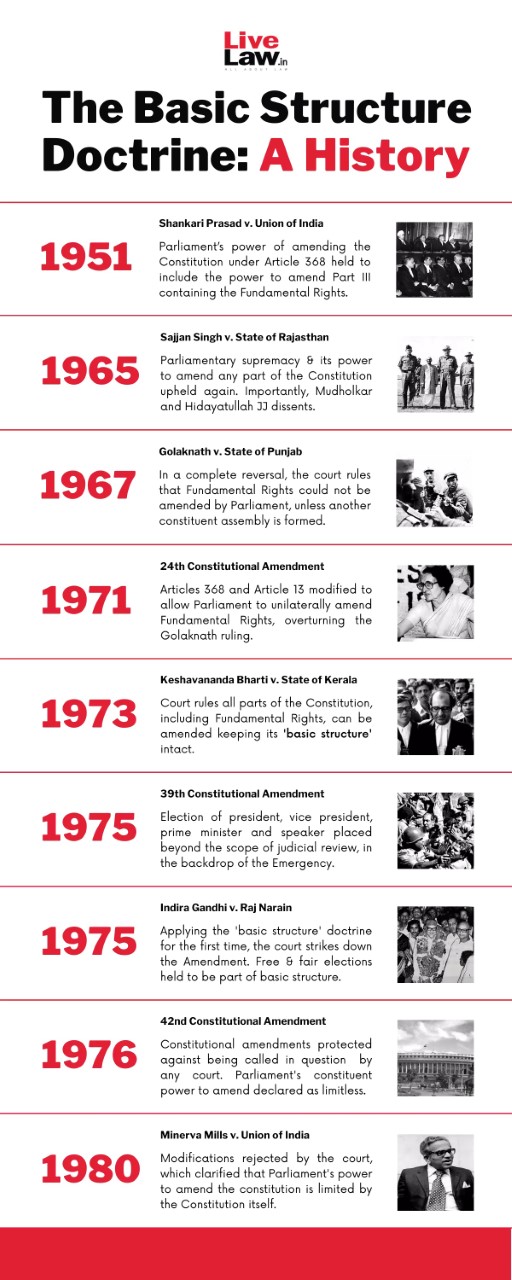Contents
- 1 Introduction
- 2 About the Kesavananda Bharati case
- 3 What is the Basic Structure Doctrine?
- 4 How did the Basic Structure Doctrine evolve over time?
- 5 What is the significance of the Basic Structure Doctrine?
- 6 What are the major concerns of experts on the Basic Structure Doctrine?
- 7 Does the Basic Structure Doctrine essential in future?
| For 7PM Editorial Archives click HERE → |
Introduction
The 50 Years of Basic Structure Doctrine marks a significant milestone in India’s constitutional history. The doctrine was established in 1973 through the landmark Kesavananda Bharati case, this doctrine has helped preserve the core principles of the Indian Constitution. Over the past five decades, the Basic Structure Doctrine has played a crucial role in maintaining a balance of power between different branches of government and safeguarding citizens’ fundamental rights. However, over the years, this doctrine has faced various challenges and debates, such as the extent of judicial intervention and the definition of its components.
About the Kesavananda Bharati case
The Kesavananda Bharati case was a landmark judgment by the Supreme Court of India in 1973. It involved a Hindu monastery head, Kesavananda Bharati, who challenged the Kerala government’s land reform acts that would cause his monastery to lose its land. This case led to a historic ruling which established the Basic Structure Doctrine, stating that Parliament cannot amend the basic structure of the Constitution.
The Supreme Court’s decision was made by a slim majority of 7 to 6 judges. The Doctrine allowed the judiciary to review constitutional amendments and strike down any that violated the basic structure. This ruling helped maintain a balance of power between the branches of government and protected citizens’ fundamental rights.
The case marked a significant power struggle between the Parliament and the Supreme Court, with the government appointing judges who were expected to favor Parliament. Despite the tense atmosphere and various challenges, the Kesavananda Bharati case remains a crucial milestone in Indian constitutional history, ensuring the Constitution’s integrity and democratic principles are preserved.
What is the Basic Structure Doctrine?
| Must read: Basic Structure Doctrine |
How did the Basic Structure Doctrine evolve over time?

| Read here: Tracing the evolution of basic structure doctrine in India highlights its salient features |
What is the significance of the Basic Structure Doctrine?
Protecting Democracy: The Basic Structure Doctrine ensures that India remains a democratic nation by preventing any political party from altering the democratic principles enshrined in the Constitution. For instance, in the 2020 Bihar state assembly elections, the Doctrine played a crucial role in upholding democratic values when the Election Commission of India conducted the elections amid the COVID-19 pandemic, ensuring free and fair elections while adhering to safety protocols. The Doctrine thus continues to guard democratic principles, even during unprecedented situations, maintaining the integrity of India’s democratic system.
Safeguarding Secularism: The Doctrine maintains the secular nature of the Indian state, protecting the freedom of individuals to practice and profess any religion of their choice. A recent example is the 2019 Supreme Court verdict on the Ayodhya land dispute case. The court ruled in favor of constructing a Ram temple at the disputed site while allocating an alternative piece of land for the construction of a mosque. This decision highlighted the secular nature of the Indian Constitution, as the court aimed to ensure a balanced outcome respecting the religious sentiments of both Hindu and Muslim communities.
Preserving Federalism: The federal character of the Indian Constitution is protected by the Doctrine, which prevents any amendments that would jeopardize the balance of power between the central government and the states. In 2019, the abrogation of Article 370, which granted special status to Jammu and Kashmir, was challenged in the Supreme Court. The court’s decision to uphold the abrogation demonstrated that it did not violate the Basic Structure Doctrine, ensuring that federalism was maintained.
Upholding Fundamental Rights: The Basic Structure Doctrine helps to secure citizens’ fundamental rights, such as the right to life, liberty, and equality, by preventing Parliament from amending these rights in a manner that would undermine the Constitution’s basic structure. In 2018, the Supreme Court decriminalized homosexuality by striking down Section 377 of the Indian Penal Code, thereby upholding the rights to equality and personal liberty.
Ensuring Judicial Independence: The Doctrine plays a crucial role in preserving the independence of the judiciary, as it prevents any amendments that would compromise the separation of powers between the legislature, the executive, and the judiciary. In 2018, the Supreme Court struck down the 99th Constitutional Amendment and the National Judicial Appointments Commission (NJAC) Act, asserting that these provisions would undermine the independence of the judiciary by giving the executive an undue influence over the appointment of judges. This decision demonstrated the importance of the Basic Structure Doctrine in preserving the separation of powers and maintaining judicial independence.
Preventing Authoritarianism: By limiting the power of the Parliament to amend the Constitution, the Basic Structure Doctrine acts as a safeguard against the rise of authoritarianism, ensuring that the government remains accountable to the people. The 2020 nationwide protests against the Citizenship Amendment Act showcased the importance of the Doctrine in protecting citizens’ rights to express dissent and hold the government accountable.
Promoting Constitutional Stability: The Doctrine contributes to the stability of the Indian Constitution by ensuring that the basic features and principles enshrined in the document remain consistent and enduring, allowing for continuity and coherence in governance. In the 2017 Right to Privacy case, the Supreme Court declared the right to privacy a fundamental right, which is now protected under the Basic Structure Doctrine, demonstrating its role in maintaining constitutional stability.
| Read more: The significance of Doctrine of Basic Structure of the Indian Constitution |
What are the major concerns of experts on the Basic Structure Doctrine?
Major Concerns of Experts on the Basic Structure Doctrine
Ambiguity: The Doctrine lacks a clear definition of the basic structure, which can lead to differing interpretations and confusion. A recent example is the 2020 debate on the Citizenship Amendment Act (CAA), where the question of whether the CAA violates the basic structure of the Constitution remains contentious. The ambiguity surrounding the Doctrine has led to differing opinions on the matter, further fueling the debate.
Judicial Overreach: Some experts argue that the Basic Structure Doctrine allows the judiciary to exercise excessive control over the legislative process. For instance, in the 2019 National Judicial Appointments Commission (NJAC) case, the Supreme Court’s decision to strike down the NJAC Act raised concerns of judicial overreach and interference with the Parliament’s power to amend the Constitution in order to reform the appointment process for judges.
Unequal Power Distribution: Critics contend that the Doctrine could disrupt the balance of power between the three branches of government. The 2019 Sabarimala case, where the Supreme Court’s verdict allowed women of all ages to enter the temple, led to concerns about the judiciary’s disproportionate influence over constitutional matters and its interference with the legislative domain on matters of religious customs and practices.
Infringement on Parliamentary Sovereignty: The Basic Structure Doctrine has raised concerns about the erosion of parliamentary sovereignty, as it limits the Parliament’s ability to amend the Constitution. The 2018 Triple Talaq Act debate saw critics arguing that the judiciary’s involvement in assessing the constitutionality of the Act might undermine the democratic principle of a representative government, thus questioning the Parliament’s role in addressing social issues.
Difficulty in Amending the Constitution: The Doctrine might make it more difficult to amend the Constitution, even when such amendments are necessary to address changing societal needs or correct perceived flaws in the document. For example, the debate surrounding the Uniform Civil Code has been hindered by concerns about violating the basic structure.
Subjectivity in Decision-Making: The lack of a definitive list of elements that constitute the basic structure can lead to subjectivity in the judiciary’s decision-making process. The 2018 verdict on Section 377 of the Indian Penal Code, which decriminalized consensual same-sex relations, illustrates the potential for subjectivity and unpredictability in the application of the Doctrine.
Potential for Political Bias: Since the determination of the basic structure is left to the judiciary, there is a risk that judges’ personal beliefs or political inclinations could influence their decisions. The 2019 Ayodhya verdict, where the Supreme Court ruled in favour of constructing a Ram Temple at the disputed site, raised concerns about the potential for political bias in the judiciary’s decision-making process.
Does the Basic Structure Doctrine essential in future?
Essentiality of the Basic Structure Doctrine in the Future
Preserving Constitutional Integrity: The Basic Structure Doctrine helps maintain the core values and principles of the Constitution. By safeguarding the fundamental elements, it ensures that the Constitution’s essence is not compromised, even as it evolves over time.
Judicial Review: The Doctrine plays a crucial role in enabling the judiciary to review and, if necessary, strike down amendments that violate the Constitution’s basic structure. This power of judicial review is essential in preserving the sanctity of the Constitution and preventing potential abuses of power.
Balancing Power: By limiting the Parliament’s ability to make sweeping constitutional amendments, the Basic Structure Doctrine helps maintain a balance of power among the branches of government. This balance is vital for the proper functioning of a democratic system.
Adaptability: While the Basic Structure Doctrine limits the scope of constitutional amendments, it also provides flexibility for the judiciary to interpret the basic structure in the context of changing societal needs. This adaptability allows the Constitution to remain relevant and effective in addressing future challenges.
Upholding Democratic Principles: By preserving the basic structure of the Constitution, the Doctrine helps uphold democratic principles, such as the rule of law, the separation of powers, and the protection of individual rights. These principles are essential for the continued functioning of a healthy democracy.
Promoting Constitutional Stability: The Basic Structure Doctrine contributes to the stability of the Constitution by preventing radical or arbitrary changes that could disrupt the nation’s political and legal systems. This stability is important for maintaining public trust in the Constitution and fostering a stable political environment.
Sources: The Hindu, Indian Express (Article 1, Article 2, Article 3 and Article 4), Hindustan Times, Outlook India, and Livelaw
Syllabus: GS 2: Indian Constitution and Polity: Indian Constitution—historical underpinnings, evolution, features, amendments, significant provisions and basic structure.
Discover more from Free UPSC IAS Preparation Syllabus and Materials For Aspirants
Subscribe to get the latest posts sent to your email.







